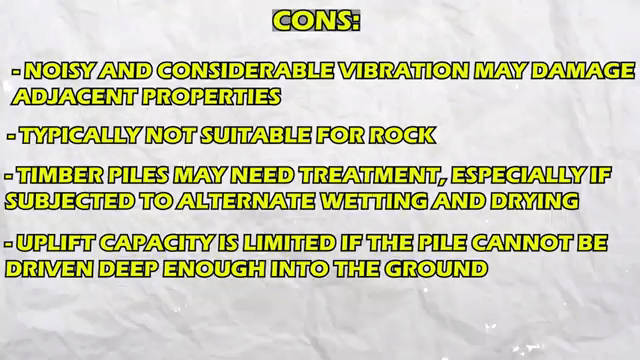Exploring Pile Foundations: Types, Applications, and Considerations in Construction
Home » Structural » Foundation »
Understanding Pile Foundations
Pile foundations are essential in construction, providing support by transferring loads from structures to the soil at deeper levels where the soil has more bearing capacity. This kind of foundation involves using long, slender columns made from materials such as concrete, steel, or timber, which are driven or installed deep into the ground. They are classified broadly into displacement and non-displacement piles, with the former displacing soil laterally and the latter involving the drilling of holes and filling them with concrete.
The effectiveness of pile foundations can be attributed to their load-bearing mechanisms, which are categorized into base bearing, shaft friction, and a combination of both. Base bearing piles rely on the strength of the pile bottom, while shaft friction piles draw strength from the friction between the pile sides and the surrounding soil. Combined types benefit from both these mechanisms.
When to Choose Pile Foundations
The choice to use pile foundations is influenced by factors like soil bearing capacity, presence of weak soil layers, and the geographic challenges of a construction site. For example, buildings on the Gold Coast requiring deep foundations due to weak soil layers use screw piles to ensure stability. Additionally, pile foundations are ideal for structures likely to experience uplift or lateral forces, such as transmission towers or tall buildings, offering a stable solution compared to massive shallow footings.
Pile foundations also prevent overload on existing structures by distributing new loads directly to deeper soil layers, thus protecting neighboring buildings and underground utilities. Moreover, pile foundations are advantageous in areas with high water tables or on sloped terrains, where they provide stability and mitigate landslide risks.
Common Pile Foundation Types
The construction industry utilizes several types of pile foundations, each with specific characteristics suitable for different conditions. Bored piles, or drilled shafts, involve drilling a cylindrical hole and filling it with concrete, sometimes with a reinforcing cage, and are known for their high load capacity. Continuous Flight Auger (CFA) piles are similar but use a continuous auger with blades to drill while concrete is pumped in, filling the space as the auger is removed.
Screw piles, another popular type, are made from steel and have one or more helixes at their tips, allowing them to be screwed into the ground using hydraulic machinery. These piles are favored for their rapid installation and minimal impact on the site. Driven piles, made from materials like timber, steel, or concrete, are hammered into the ground, displacing soil around the shaft to gain load-bearing capacity.
Pros and Cons of Different Pile Types
Each pile type comes with its advantages and limitations. Bored piles, for instance, are suitable for high-load requirements and can be crafted with an enlarged base to increase capacity. They are, however, less effective in soils with shallow water tables or collapsible characteristics. Screw piles provide a quick, vibration-free installation but may struggle in rocky conditions or where debris is present. Driven piles are fast to install and effective in various soil conditions but can cause significant vibration, potentially affecting nearby structures.
Micro piles, which are smaller diameter piles, are generally used for underpinning or strengthening existing foundations. They can be installed in confined spaces with minimal noise and spoil removal, though they are not suitable for carrying very large loads.
Challenges and Considerations in Using Piles
While piles are a versatile and effective foundation solution, they must be chosen and used carefully, especially in sensitive environmental conditions. For instance, drilling on sites above closed landfills or hazardous waste areas can release harmful gases or even trigger explosions. Engineers must assess such risks and plan accordingly to ensure safety and structural integrity.
In conclusion, understanding the various types of pile foundations and their appropriate applications ensures the stability and longevity of structures while mitigating potential risks. As construction technology advances, the application and efficiency of different pile types continue to evolve, allowing for more innovative approaches to overcoming geotechnical challenges.










